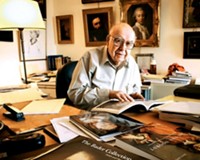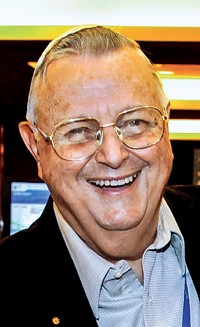Advertisement
Grab your lab coat. Let's get started
Welcome!
Welcome!
Create an account below to get 6 C&EN articles per month, receive newsletters and more - all free.
It seems this is your first time logging in online. Please enter the following information to continue.
As an ACS member you automatically get access to this site. All we need is few more details to create your reading experience.
Not you? Sign in with a different account.
Not you? Sign in with a different account.
ERROR 1
ERROR 1
ERROR 2
ERROR 2
ERROR 2
ERROR 2
ERROR 2
Password and Confirm password must match.
If you have an ACS member number, please enter it here so we can link this account to your membership. (optional)
ERROR 2
ACS values your privacy. By submitting your information, you are gaining access to C&EN and subscribing to our weekly newsletter. We use the information you provide to make your reading experience better, and we will never sell your data to third party members.
People
Celebrating Alfred Bader At 90
C&EN lauds the myriad contributions of the chemist, art collector, and philanthropist
by Linda Wang
April 27, 2014
| A version of this story appeared in
Volume 92, Issue 17

Alfred Bader may be best known for cofounding Aldrich Chemical Co. (now part of Sigma-Aldrich) in 1951, and for being a preeminent art collector, but it’s his enormous body of charitable work that may be his greatest legacy.
With his wife, Isabel, Bader has given millions of dollars to causes he’s passionate about, including the American Chemical Society’s Project SEED program, which provides scholarships to economically disadvantaged high school students to conduct hands-on research. In addition, since 1986, the Baders have supported an ACS national award, the Alfred Bader Award in Bioinorganic or Bioorganic Chemistry.
In celebration of Bader’s 90th birthday this month, C&EN reflects on the contributions of this multifaceted chemist, businessman, art collector, and champion for chemistry education.
“Eighty years ago, when Alfred and I were in the same class in Vienna, I would never have imagined that he would become one of the great polymaths: scientist, yet religious; spectacular entrepreneur as well as even more spectacular philanthropist; sophisticated art dealer as well as major collector: all these boats sailing on a sea of chemistry!”
—Carl Djerassi, emeritus professor of chemistry, Stanford University
“The Bader Scholarship was instrumental in allowing me to put more emphasis on my classes instead of thinking of the financial burden I might be to my parents. Thank you, Mr. and Mrs. Bader, for investing in my education.”
—Anita Hurtado, former Bader Scholar, now associate director in the Supply-Chain Organization at Merck & Co.
“Alfred and Isabel Bader’s generosity has manifested itself at ACS in countless ways—and there are countless successful chemists who owe their careers to the investments that these two astonishing philanthropists made in Project SEED and the Bader Scholarships.”
—Madeleine Jacobs, ACS executive director and CEO

"No one on this planet has done more to further chemists' capabilities and all chemical industries' ability to grow."
—K. Barry Sharpless, W. M. Keck Professor of Chemistry, Scripps Research Institute, California
"Alfred Bader's name is synonymous with helping chemists to make molecules; furthermore, his support through awards, fellowships, and scholarships is unwavering. But more than that, Alfred, with Isabel at his side, has touched all whom he has met with enthusiasm about their work and a zest for life."
—Victor Snieckus, Bader Chair Emeritus in Organic Chemistry, Queen's University, Ontario
"Please bother us."
This statement by Alfred Bader became associated with Aldrich Chemical Co., which took pride in talking with its customers.



Aldrich Chemical Co.'s first chemical:
N-Methyl-N′-nitro-N-nitrosoguanidine, which was used in the preparation of diazomethane. MNNG was marketed through the company's first catalog, in 1951, a one-page document that grew to become the Aldrich Handbook. Sigma-Aldrich no longer sells MNNG, a potent mutagen and carcinogen.


"It would seem unlikely that any person could be a renowned authority on paintings and fine artworks, synthetic chemistry, science history, and running a major science-based corporation. But I can say, 'Yes, it's possible,' and that person is Alfred Bader."
—Elias J. Corey, emeritus professor of chemistry, Harvard University




Join the conversation
Contact the reporter
Submit a Letter to the Editor for publication
Engage with us on Twitter